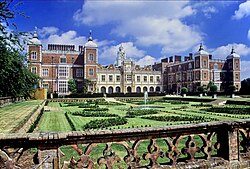
Back Hatfield House Afrikaans هاتفيلد هاوس Arabic Хатфийлд хаус Bulgarian Hatfield House Catalan Hatfield House German Χάτφηλντ Χάουζ Greek Hatfield House Spanish Hatfield House French Hatfield House Irish Hatfield House Italian
| Hatfield House | |
|---|---|
 South-facing view of Hatfield House | |
| Type | Prodigy house |
| Location | Hatfield, Hertfordshire |
| Coordinates | 51°45′38″N 0°12′33″W / 51.7606°N 0.2092°W |
| OS grid reference | TL 23715 08394 |
| Built | 1607-1612 |
| Architectural style(s) | Jacobean |
| Owner | Robert Gascoyne-Cecil |
Listed Building – Grade I | |
| Official name | Hatfield House |
| Designated | 6 February 1952 |
| Reference no. | 1173363 |
| Official name | Hatfield House |
| Designated | 11 June 1987 |
| Reference no. | 1000343 |
| The Old Palace, Hatfield House | |
|---|---|
 The Old Palace, Hatfield House | |
| Type | Bishop's Palace |
| Location | Hatfield |
| Coordinates | 51°45′40″N 0°12′39″W / 51.76119°N 0.21070°W |
| Area | Hertfordshire |
| Built | c.1480 |
| Architectural style(s) | Medieval and Tudor |
Listed Building – Grade I | |
| Official name | The Palace |
| Designated | 6 February 1952 |
| Reference no. | 1348152 |
Hatfield House is a Grade I listed[1] country house set in a large park, the Great Park, on the eastern side of the town of Hatfield, Hertfordshire, England. The present Jacobean house, a leading example of the prodigy house, was built in 1611 by Robert Cecil, 1st Earl of Salisbury and Chief Minister to King James I. It is a prime example of Jacobean architecture. The estate includes extensive grounds and surviving parts of an earlier palace. Queen Elizabeth's Oak is said to be the place where Elizabeth I was informed she had become queen. The house is currently the home of Robert Gascoyne-Cecil, 7th Marquess of Salisbury. It is open to the public.
- ^ Historic England. "Hatfield House (1173363)". National Heritage List for England. Retrieved 11 August 2023.
